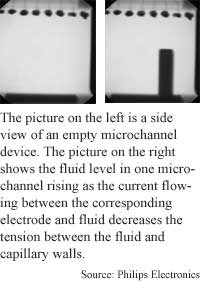
Electricity moves fluids
By Kimberly Patch, Technology Research NewsResearchers from Philips are using electricity to control fluid in networks of very small channels.
The researchers made fluid flow through the 20-millimeter-long channels at a rate of several centimeters per second. The channels are 350 microns wide, or about four times the diameter of a human hair, and there are about 4,000 of them in the researcherís microchannel device.
The inside of each channel is coated with a 20-nanometer layer of aluminum, an 11.5 nanometer insulating layer, and a 10 nanometer hydrophobic coating. This setup, together with liquid in the microchannel, is effectively a capacitor, with the aluminum acting as one electrode and the liquid as a second electrode. A capacitor is a device that stores electric charge.
When the capacitor is charged, the tension between the fluid and wall decreases, which draws the fluid into the channel. In a device with many channels, this pushes the liquid along at a rate that is useful.
"We wanted to achieve fast control of liquids in a device with thousands of micro-scale channels," said Menno Prins, a senior scientist at Philips Research.
The technique could be used to quickly transport fluids that conduct electricity, like water or saltwater, in microelectromechanical systems (MEMS) without having to use external pumps.
The technique also allows for dynamic control of fluid in MEMS because the researchers can shift the pressure in a channel at will. "In present-day devices the capillary pressures are static and fixed by the channel dimensions," said Prins.
MEMS using this type of flow control could eventually be used to quickly mix fluids in lab-on-a-computer-chip devices. "With [electrocapillary pressure] more accurate, complex and flexible chips become feasible," said Prins.
Finely controlled microchannel devices may also eventually be used in printers to achieve higher resolution printing, according to Prins.
In addition, changing the level of water changes its optical properties: transparency, reflectivity and absorption of light. Devices that allow for fine control of these properties could eventually be used to switch optical signals and to filter x-rays to gain better image quality at lower radiation doses, according to Prins.
The researchers came up with the idea while looking for a nonmechanical way to control fluids in microscale devices, said Prins. They chose electrocapillary pressure "because of its promises in terms of device speed and the direct electric control. Besides speed it has given us several other advantages -- high reversibility [and] low-power," he said.
The research is "interesting and solid" and provides another fluid manipulation technique for the emerging field of microfluidics, said David Beebe, an assistant professor of biomedical engineering at the University of Wisconsin. "It gives the designer more methods from which to choose."
The approach overcomes a couple limitations of other electrically driven flow mechanisms because it avoids electrolysis and does not consume very much power, Beebe added. It has its own limitations however: "the use of relatively high voltages and [relatively complicated] electrode/insulator/coating could limit [it's] use, but it clearly will have important niche applications," he said.
Because the devices can be readily interfaced to electronic systems, they will "likely first find use in systems that already have an electronic infrastructure," Beebe said. Practical electrocapillary devices could be made within two years, he said.
Prins' research colleagues were W. J. J. Welters and J. W. Weekamp. They published the research in the January 12, 2001 issue of Science. The research was funded by Philips Research.
Timeline: <2 years
Funding: Corporate
TRN Categories: MicroElectroMechanical Systems (MEMS)
Story Type: News
Related Elements: Technical paper, "Fluid Control in Multichannel Structures by Electric Capillary Pressure," Science, January 12, 2001.
Advertisements:
March 7, 2001
Page One
Neuron-chip link advances
Electricity moves fluids
Quantum effect makes fast connections
Chain reaction yields microscopic wires
Noise can bring quiet surprise


News:
Research News Roundup
Research Watch blog
Features:
View from the High Ground Q&A
How It Works
RSS Feeds:
News
Ad links:
Buy an ad link
| Advertisements:
|
 |
Ad links: Clear History
Buy an ad link
|
TRN
Newswire and Headline Feeds for Web sites
|
© Copyright Technology Research News, LLC 2000-2006. All rights reserved.